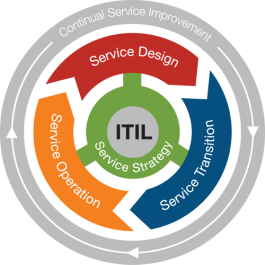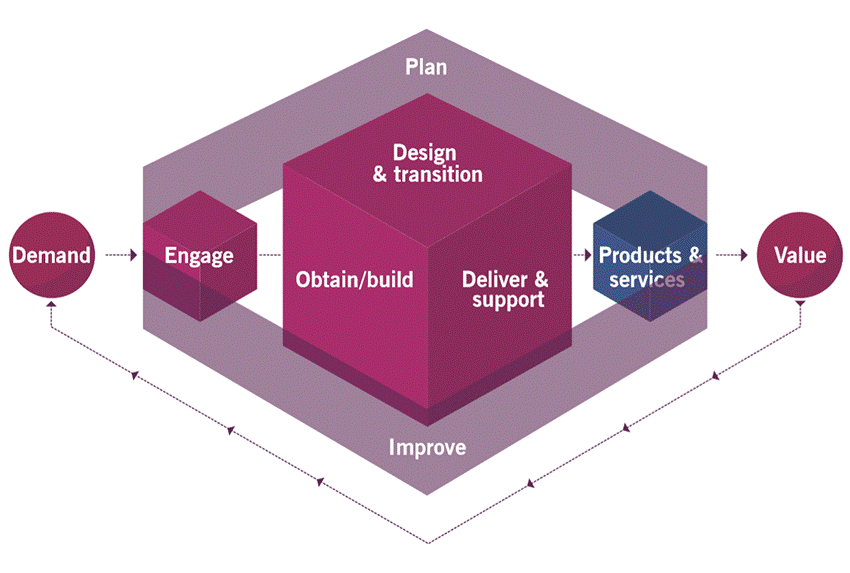What happened to the ITIL service lifecycle in ITIL 4?

If you’ve checked out the ITIL 4 best practice guidance or the guide on ITIL, you might be wondering what happened to the ITIL service lifecycle we first saw in ITIL v3. Well, it’s no longer there. Before I elaborate on what happened to the service lifecycle in ITIL 4, here’s a quick recap of what it is.
The ITIL service lifecycle explained
The ITIL v3 best practice guidance is built around the concept of a service lifecycle. The five stages of the service lifecycle correspond to the five ITIL v3 publications. The stages all work together to allow service organizations to envision, design, agree, deliver, support, and improve the IT and business services that their service-receiving organizations need. Think of it as a wheel that service organizations travel around when operating, including the need for continual improvement.

Source: AXELOS, ITIL v3/2011
The five stages of the ITIL service lifecycle
So, what happens in each of the five stages of the service lifecycle? Here’s a quick overview based on the ITIL 2011 Glossary:
- Service strategy “defines the perspective, position, plans and patterns that a service provider needs to execute to meet an organization’s business outcomes.”
- Service design “includes the design of the services, governing practices, processes and policies required to realize the service provider’s strategy and to facilitate the introduction of services into supported environments.”
- Service transition “ensures that new, modified or retired services meet the expectations of the business as documented in the service strategy and service design stages of the lifecycle.”
- Service operation “coordinates and carries out the activities and processes required to deliver and manage services at agreed levels to business users and customers. Service operation also manages the technology that is used to deliver and support services.”
- Continual service improvement (CSI) “ensures that services are aligned with changing business needs by identifying and implementing improvements to IT services that support business processes.”
How ITIL 4 changed the ITIL service lifecycle
The quick answer to what happened to the service lifecycle in ITIL 4 is that it disappeared completely when the ITIL 4 Foundation publication came out in February 2019. The ITIL 4 approach and best practice guidance is now built around the service value system and service value chain:

Source: AXELOS, ITIL Foundation ITIL 4 Edition (2019)
Don’t worry: the service lifecycle isn’t dead (or consigned to history): it can still help service organizations. If you want to continue to use the service lifecycle approach, you have three options:
- Simply continue to use the ITIL v3 guidance – and ignore ITIL 4.
- Replicate the ITIL service lifecycle using the ITIL 4 service value chain.
- View the ITIL 4 guidance through an ITIL service lifecycle lens. In other words: continue to use the ITIL service lifecycle while adopting the newer ITIL 4 practices over the ITIL v3 processes.
I’ll explain each of your options in more detail below.
Option 1: Continue to use the ITIL v3 guidance
This is basically the “do nothing” option.
If ITIL v3 is working for your organization, you might think that an “if it ain’t broke, don’t fix it” approach will work for you. And yes, it’ll definitely save your organization from the necessary investment in the ITIL 4 approach and the associated disruption caused by the various changes to the status quo.
On the other hand, there are a number of good reasons why ITIL v3 needed to be updated, including the impact of the changes in the technologies that need to be managed and the expectations of organizations.
If you go for option 1, your organization won’t benefit from the new ITIL best practices that address these and other ITSM ecosystem and business changes. As you’ll see later, option 3 is more appropriate if you want to hold on to the service lifecycle.
Option 2: Replicate the ITIL service lifecycle using the ITIL 4 service value chain
Options two and three are very similar. In both options, you continue to use the ITIL v3 service lifecycle along with the newer ITIL 4 best practices across the 34 ITIL management practices.
The difference is that option two uses the ITIL 4 service value chain approach, which recognizes that the ITIL v3 service lifecycle stems from a time when IT used a waterfall approach to change. In contrast, ITIL 4’s new value stream approach is fit for both waterfall and iterative methodologies.
So how can you replicate the service lifecycle using the service value chain? Use the various value chain activities as follows:
- Engage – starting with what was service strategy in ITIL v3: finding out what’s needed (demand);
- Plan – elements of service strategy and service design;
- Design & Transition – service design;
- Obtain/Build – elements of service design and service transition;
- Design & Transition – service transition;
- Deliver & Support – service operation (including value creation);
- Improve – with what was continual service improvement (CSI), hopefully happening throughout.
Realistically though, if your organization wants to use the service value chain, you’re more likely to fully adopt the concept rather than a hybrid of old and new approaches. That’s why option three is a more likely option if you want to continue to use the service lifecycle.
Option 3: View and use the ITIL 4 practice guidance through an ITIL service lifecycle lens
There are many benefits in choosing this option over the previous two.
Firstly, this option involves adopting the latest service management best practice from the many ITIL authors who help organizations improve their service delivery and support. ITIL 4 has many improvements compared to ITIL v3, including the laser focus on value creation (or co-creation), the elevation of capability-based thinking from processes to practices and additional practices such as IT asset management, the inclusion of the ITIL guiding principles that were introduced in 2016’s ITIL Practitioner Guidance publication, and the change from CSI to continual improvement that recognizes that you need to improve more than just services.
Secondly, the ITIL v3 service lifecycle can easily be understood and used by organizations, for example as the model for creating new or changed services. Here, the service lifecycle makes it easier to explain what’s needed to create new services or change or improve existing services.
Thirdly, the ITIL service lifecycle is a much more convenient way to group the 26 processes and four functions of ITIL v3 compared to the three less descriptive groupings of ITIL 4’s 34 management practices: general management practices, service management practices, and technology management practices.
Ultimately, ITIL is about “adopting and adapting.” Use the ITIL service lifecycle as best fits your organization’s needs.
What does this mean for IT departments?
So, what does the loss of the ITIL service lifecycle mean for you? It depends on how you and your organization view the value of the service lifecycle.
If the service lifecycle is a vital part of ITIL adoption and use for you and your organization, there’s likely value in continuing to use it, ideally via option three. Which option you choose will likely depend on your organization’s affinity with the service value chain and the creation of value streams in ITIL 4 though.
If the service lifecycle isn’t vital to your organization though, you should adopt ITIL 4’s service value system and service value chain. Instead of creating new or changed IT services using the service lifecycle, the service value chain will provide the platform for service creation. Starting from demand on the left, working through to value on the right. This includes the creation of IT’s own capabilities and not just the services offered to customers.
For many people though, the service lifecycle makes it easier to understand the spectrum of ITIL guidance. So, if you want to continue to use the service lifecycle and its stages to better understand the different types of ITIL 4 practices, why not? Ultimately, ITIL is about “adopting and adapting.” Use the ITIL service lifecycle as best fits your organization’s needs – this may include continuing to use the service lifecycle to better understand the ITIL 4 practices.
ITIL incident management best practices
As you navigate the complexities of ITIL 4, don't overlook your incident management processes. No matter the changes introduced in ITIL 4, incident management remains a critical part of ITIL and IT Service Management (ITSM) in general. Discover 5 ITIL incident management best practices in this blog by industry expert Stephen Mann.
Inspire others, share this blog



